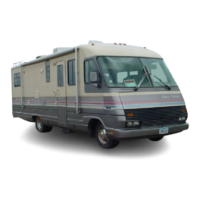ON
THE
ROAD
MOTOR
HOME
LOADING
A
motor
home
chassis (springs, wheels, tires, axles,
and
frame) is
designed
to
carry
a certain
maximum
load.
This,load includes everything:
the
weight
of
the
empty
motor
home
itself,
your
belongings, fuel, fresh
water,
waste
water
and
anything
else
that
may
be
in
or
attached
to
the
motor
home. The
maximum
load
for
which
the
motor
home
is designed is called
the
'GROSS
VEHICLE WEIGHT RATING (GVWR).
Another
critical
weight
factor
is
the
GROSS AXLE
WEIGHT
RATING (GAWR). This is
the
maximum
weight
a
specific
axle
is
designed
to
carry and each
axle
has
its.
own
GAWR. The GAWR's do
not
necessarily
add
up
to
the
GVWR. Be careful,
neither
the
axle loads
nor
the
vehicle loads
must
ever ex-
ceed
their
respective
weight
r~tings.
In
addition
to
knowing
the
overall
weight
that
can
be
safely
loaded in or
attached
to
the
motor
home,
you
must
know
how
to
distribute
the
weightso
that
correct
amounts
of
weight
are placed on
the
axles.
The
allowable
carrying
capacity
of
the
motor
home
is
found
by weighing the
motor
home empty, and sub-
tracting
this
weight
from
the
GVWR.
CARRYING CAPACITY
During
the
design
and development
of
our
motor
homes,
the
number
and size
of
storage compartments,
the
liquid
tank
capacities and number
of
belted seating
positions
are
maximized
for
value and convenience.
If
the
,motor
home
operator
fills ail"liquid tanks
to
capacity, fills all storage compartments and cupboards
to
maximum
volume and fills all available seating posi-
tions
with
passengers,
the
motor
home
will
probably
be
overloaded.
According
to
National
Highway
Traf-
fic
Safety
Administration
figures, an average vehicle
occupant
weighs
150
pounds, each'gallon
of
gasoline
weights
six
pounds
(6.0
Ibs.) and each gallon
of
water
weights
over
eight
pounds
(8;3 Ibs.).
The
operator
is
responsible
for
analyzing
the
con-
ditions
in
which
the
motor
home
will
be utilized
for
each
trip.
The
number
of
passengers and placement
of
cargo
will
affect
the
amount
of
water
and cargo
that
you
Can
carry
(See Loading Tips). For conve-
nience.,
the
passenger
capacity
for
camping use and
the
passenger
capacity
for
day use' are
shown
on a
permanent
label
in
the
driver's
area or adjacent
to
the
main
entry
door. The smaller passenger
capacity
for
camping
provides reasonable cargo
capacity
for
trips
taking
more
than
one day. The larger passenger
capacity
for
day
lise
provides less cargo
capacity
for
trips.
or
acitivites
not
involving overnight ·stays. It may
be
necessary
to
reduce
the
amount
of
water
carried
and
unload
some
cargo items
normally
carried for
camping
in
order
to
provide carrying
capacity
for
the
additional
day
use passengers.
The number
of
safety
belted seating
locations
may
be greater than
the
number
of
passengers
permitted
by
the
label. These extra seating locations,
if
provid·
ed, are
to
permit
a choice
of
seats
while
traveling.
It
is
not
safe
to
exceed the labeled passenger
capacity
unless
the
axle loadings and
total
weight
are
check-
ed against their ratings on a public scale.
Thoughtful
consideration
of
the
weight
placed in
the
motor
home can yield
important
benefits:
•
•
•
•
maximum
flexibility
in
the
use
of
the
seating
and liberal storage facilities provided in
the
motor
home;
operatio'n
without
unsafe loading;
improved handling characteristics and ride
comfort;
better fuel mileage and reduced tire wear.
NOTE: CARRYING CAPACITIES OF YOUR
MOTOR HOME ARE SPECIFIED
ON
A LABEL AF-
FIXED
TO
THE
INSIDE
OF
A WARDROBE DOOR.
THE LABEL INCLUDES ALL FACTORY INSTALL-
ED
OPTIONS. IF
OTHER
EQUIPMENT SUCH
AS
LEVELING JACKS, AWNINGS, ROOF PODS,
ETC..
ARE INSTALLED AFTER THE MOTOR
HOME
LEAVES
THE
FACTORY,
THE WEIGHT OF
THESE .ITEMS
MUST
BE
SUBTRACTED FROM
THE TOTAL
OF
THE PASSENGER
AND
CARGO
CARRYING CAPACITIES. IF YOU
TOW
A
TRAILER, THE TONGUE WEIGHT OF THE
TRAILER MUST
BE
SUBTRACTED FROM THE
TOTAL
OF
THE PASSENGER
AND
CARGO CAR-
RYING CAPACITIES.
DETERMINING
AND
DISTRIBUTING
.
YOUR
MOTOR"HOME LOAD
The Gross Vehicle Weight Rating (GVWR) and
the
Gross Axle
Weight
Rating (GAWA)
for
your
motor
home are shown
on
the
certification
tag posted
on
the
driver's door
or
in the driver's
compartment.
Remember, these ratings are
for
a
fully
loaded
vehi·
cle.
YOl!must
compare
the
GVWR
to
the
loaded
.,
weight
'of your
motor
home.
If
the
loaded
weight
of
your.
motor home exceeds the GVWR, the
motor
home
is overloaded and
you'll
have
to
remove items
to
bring
the
weight
down
to
or below
the
GVWR.
If
the
load-
ed axle
weight
on any axle exceeds
the
GAWR,
the
axle
is
overloaded and you'll have
to
redistribute cargo
to
bring
the
weight
down
to
or
below
the
GAWR.
13
Weighing
Your
Loaded
Motor
Home
1.
Drive the
front
wheels
onto
the scale
platform
and take a reading. This is the
front
Gross
Axle
Weight, (Reading'
1),

